The Culture Which Gave Rise to Mark Driscoll, Part 3
Part 1: “We Are Not ABANDONED”
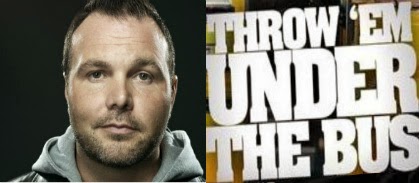 |
| “You either get on the bus or you get run over by the bus. Those are the options; but the bus ain’t gonna stop.” -Mark Driscoll[1] |
“To
decide where to drive the bus before you have the right people on the
bus,
and the wrong people off the bus,
is absolutely the wrong
approach.”
“…if you have the wrong people on the bus, nothing else matters.
You may
be headed in the right direction,
but you still won’t achieve greatness.
Great vision with mediocre people still produces mediocre results.”
– Jim Collins[2]
Every day you’ll see the dust (Too much, the Magic Bus)
As I drive my baby in my Magic Bus (Too much, the Magic Bus)
– “Magic Bus,” The Who
 |
| Jim Collins, Good To Great, p. 41.[3] |
Whoever heard of a transit authority that kicks people off its buses? How can one run a business this way? Leave it to Jim Collins, the management guru who trained several generations of MegaChurch, New Calvinist and Emergent leaders, to come up with such a radical idea.
Collins taught evangelical leaders his brand of “tossing people off the bus,” including his own unique methodology. He advised bus drivers (i.e., church leaders) that before going in a certain direction they first needed to purge their bus of the “wrong people.” Yep! That’s right! Toss out the unruly “wrong people” that don’t fit on the bus. Keep the “right people” on the bus and then get going on your mission to fulfill your vision. The following statement by Collins is alarmingly blunt:
You are a bus driver. The bus, your company, is at a standstill, and it’s your job to get it going. You have to decide where you’re going, how you’re going to get there, and who’s going with you.
Most people assume that great bus drivers (read: business leaders) immediately start the journey by announcing to the people on the bus where they’re going—by setting a new direction or by articulating a fresh corporate vision.
In fact, leaders of companies that go from good to great start not with “where” but with “who.” They start by getting the right people on the bus, the wrong people off the bus, and the right people in the right seats. And they stick with that discipline—first the people, then the direction—no matter how dire the circumstances….[4][emphasis added]
Collins cited David Maxwell, identified as “CEO of Fannie Mae in 1981” when it was losing “$1 million every business day,” as a role model for providing “seats on the bus for A-level people.” Obviously no B-level people allowed, only the “smartest, and hardest working” people can sit on this bus:
Maxwell told his management team that there would only be seats on the bus for A-level people who were willing to put out A-plus effort. He interviewed every member of the team. He told them all the same thing: It was going to be a tough ride, a very demanding trip. If they didn’t want to go, fine; just say so. Now’s the time to get off the bus, he said. No questions asked, no recriminations. In all, 14 of 26 executives got off the bus. They were replaced by some of the best, smartest, and hardest-working executives in the world of finance.[5][emphasis added]
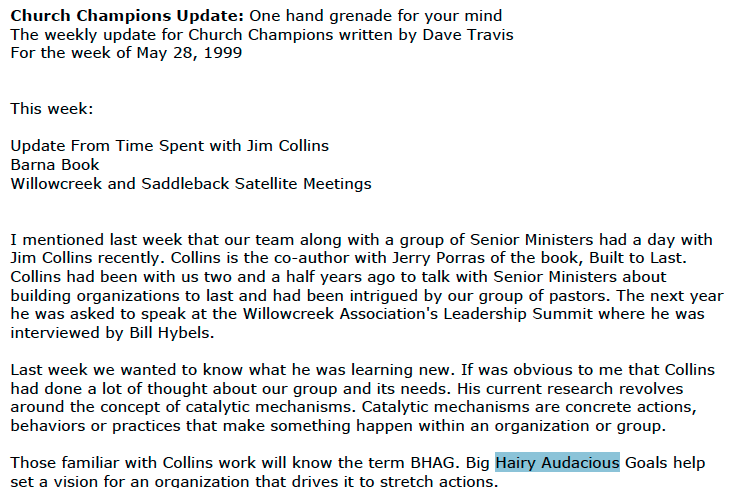 |
| Collins’ training for Leadership Network described, 1999 |
Collins wrote “three simple truths” about this bus ride that ensures the “right people” get on the bus. Notice the condescension. If you are a wannabe “good-to-great” CEO-type leader you need to have the “right people” on your bus. Ensuring this means you will be “faster and smarter,” “self-motivated,” and can “produce great results.” But if don’t do this properly, you will “have the wrong people on the bus,” you “won’t achieve greatness,” and will end up with with “mediocre people” and “mediocre results.”
When it comes to getting started, good-to-great leaders understand three simple truths. First, if you begin with “who,” you can more easily adapt to a fast-changing world. If people get on your bus because of where they think it’s going, you’ll be in trouble when you get 10 miles down the road and discover that you need to change direction because the world has changed. But if people board the bus principally because of all the other great people on the bus, you’ll be much faster and smarter in responding to changing conditions. Second, if you have the right people on your bus, you don’t need to worry about motivating them. The right people are self-motivated: Nothing beats being part of a team that is expected to produce great results. And third, if you have the wrong people on the bus, nothing else matters. You may be headed in the right direction, but you still won’t achieve greatness. Great vision with mediocre people still produces mediocre results.[6][emphasis added]
 |
| NEXT, Leadership Network promotion of Jim Collins, May 1997 |
Bus Driver Training
Jim Collins’ influence over leaders like Mark Driscoll was extraordinary. Many of the “buzz terms” used by Mega-Emergent-Missional (whatever) leaders were borrowed from Collins, such as the bus motif, “Big Hairy Audacious Goal,” and “Level 5 Leader,” etc. The early Leadership Network-trained pastors were exposed to Collins’ style, which included a dose of Ying/Yang Eastern mysticism (look at the clock graphic and subheading graphics) in the May 1997 issue of Leadership Network’s NEXT newsletter.
Below are examples of the teachings of Jim Collins that have permeated the evangelical subculture in America. Because Collins is a business/management guru, these teachings are also commonplace in the corporate sector. As we pointed out in Part 1 and Part 2 of this series, the original idea of “abandon” as articulated by Peter Drucker is essentially the same bus concept taught by Collins. While Drucker first applied this to manufacturing, it was quickly interpolated to human relationship dynamics. Thus tossing PEOPLE off the bus when they weren’t “effective” (a favorite term of Drucker’s) has become the norm across society. It is unfortunate that the evangelical church world — which should have functioned as a conscience, and defended and supported people who were getting thrown under the bus — chose rather to adopt this very method, and even perfected it in the church.
Here is what Collins teaches about a “Level 5 Leader.” Notice that a key qualification is that he must “Get the right people on the bus.” Supposedly Jesus is a Level 5 Leader model. What would Jesus do? Would Jesus toss off those people who aren’t the “right people”? This seems to be the dreadful implication.
 |
| Jim Collins, Good To Great, p. 47 |
Note in the next excerpt from Good To Great (text below) what Collins teaches about “Letting the wrong people hang around.” It is “unfair to all the right people.” Really?! This sounds like a Junior High clique in the extreme. For example, those who are in (hip, cool, on the cutting edge) don’t want the untouchables (unhip, uncool, etc.) around. It might spoil their fun party, ‘er their bus ride.
In fact, this first sentence in the text below could function as the mantra of this entire megachurch/emergent movements. The peer-driven culture of the MegaChurch Transit Authority does not want to let the “wrong people hang around it.” They’ve made this abundantly clear. If you are not postmodern (the new authority), you’re tossed off the bus. Note: any holding traditional views are summarily dismissed. Seeker-sensitive has replaced “salt and light” as the new operating system in the church. Old fogies must go!
BUT, if you are on the cutting edge of pushing the boundaries of immorality, new theology, and new ways of doing church — Hey! You’re in! You are the “right people.” As long as you promote the postmodern brand and/or logo (by whatever name), you can ride this bus!
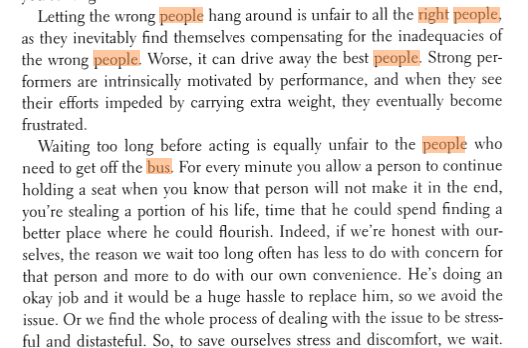 |
| Jim Collins, Good To Great,p. 55 |
Notice also the language of the second paragraph above. Collins makes it sound like the leader is doing a favor to the “people who need to get off the bus,” i.e., the “wrong people.” It is for the own good that you toss them off the bus. They need to be tossed off, so that they can find a “better place where [they] can flourish.” How nice…. How sweet…. You’re doing them a favor. They’ll feel so much better once they recover from their injuries, wounds and traumas of being hurled overboard and run over.
 |
| Jim Collins, Good To Great,p. 50 |
Here is a summary point, which appears highlighted in a box in Good To Great. This may explain the ideology behind financial fiascos[7] accompanying the bus fiascos at Mars Hill. Salary (“compensation”) is how “to get the right people on the bus in the first place, and… keep them there.” Bus driving can be a lucrative business, but it takes a lot of semantic, legal and financial deception to dupe the riders into paying the high fares for salaries of the “Level 5 Leaders.” In fact, more stories keep coming out — many got tossed off the bus for merely asking questions when they stumbled across these deceptions. Oops! The “right people” don’t ask questions!
 |
| Advertised by Leadership Network, email dated October 2, 2014, http://thenines.tv Salt and light? Or seeker sensitive? |
“Bullies” in the Church
This “toss off the bus” ideology now seems endemic in the evangelical church world. It was a major facet of Rick Warren’s Purpose-Driven strategy and operation. Dan Southerland wrote a key book in 2000 Transitioning: Leading Your Church Through Change which details this “vision.” Pastor Bob DeWaay critiqued it:
Rick Warren wrote the forward to Dan Southerland‘s book entitled “Transitioning: Leading Your Church Through Change”. The book is designed to show pastors how to transition their traditional church into a Purpose Driven one. Rick Warren sells the book on the Purpose Driven website.
Some of the chapter headings reveal how heavily it depends on the concept of vision: “Preparing for Vision; Defining Vision; Planting the Vision; Sharing the Vision; Implementing the Vision, etc”. The future Purpose Driven Church is what the vision is all about. The vision includes the process of removing people who oppose becoming Purpose Driven. This book is very revealing.
Reading Southerland’s book will help people whose churches have changed from gospel preaching and Bible teaching churches to seeker churches understand what happened to them. Southerland characterizes those who resist this transition as “leaders from hell” who are of the ilk of Sanballat who resisted Nehemiah on a mission from God (ie: to convert the church to being a Purpose Driven seeker church) and that all who resist are misguided, have evil motives, or are just unwilling to change because of their being caught in traditions.[8][emphasis added]
In another critique of Southerland by Gary Gilley, more of this dump-the-sheep philosophy is explained. Note: just because a member chooses to leave doesn’t mean he didn’t feel dumped off the bus. There is usually a series of bad things that start happening, leading up to the actual leaving (however it happens):
Transitioning to the Flamingo Road model will require radical change such as replacing traditional music with “extremely” contemporary, becoming staff-led rather than deacon- or elder-led and replacing Sunday school with small groups. Some of these changes will anger more traditional members, some of whom may leave (pp. 102-103). But not to worry, Flamingo Road lost 300 traditionalists but gained 2000 people (p. 127). Some traditionalist don’t leave, they just become critical, but Southerland sees all such people as ornery or wolves, and their criticism is not worth considering (pp. 116-117, 125, 127-128, 153).[9][emphasis added]
Pastor Larry DeBruyn also wrote about this phenomena in his 2007 book Church on the Rise: Why I am not a “Purpose-Driven” Pastor[10]: Notice in the quotation from Church Transitions Inc. that not only is the congregant tossed off the bus in one church, but that when they tried to board the next bus, they discover that they will be “barred” there too. This explains the awful experiences that some have reported. Once tagged as the “wrong people” the label can follow you for life:
Transitioning a Local Church
How can a church be managed in its move from traditional to contemporary and Purpose-Driven? Though not officially affiliated with Purpose-Driven, but working according to the organization’s philosophy, the company Church Transitions Inc. instructs pastors on how to affect change from traditional to contemporary in their local churches. Some of the methods employed are underhanded. Others are highhanded.
A national newspaper reported that in one Church Transitions seminar, leaders and pastors were coached “to trust very few people with their plans.” Then they were warned, “All the forces of hell are going to come at you when you wake up that church.”[i] Then in a seminar session called “Dealing with Opposition,” the leadership advised seminarians to,
. . . speak to critical members, [and] then help them leave if they don’t stop objecting. Then when those congregants join a new church . . . pastors should call their new minister and suggest that the congregants be barred from any leadership role.[ii]
The president of Church Transitions Inc., the Rev. Dan Southerland, remarked,
There are moments when you’ve got to play hardball. You cannot transition a church . . . and placate every whiny Christian along the way.[iii]
 |
| An example of “bullies” language surrounding Mars Hill fiasco |
Pastor Larry DeBruyn began the next section of his book by describing “‘Bullies’ in the Church.” Interestingly, he came up with this subtitle back in 2007 long before the Driscoll mess came to be identified with this same idea — bullying. In the first paragraph Pastor Larry aptly summarized the problem:
“Bullies” in the Church
Thus, the methods of Church Transitions can be summarized: With the under hand, work clandestinely. “Don’t tell the folks what the plan is for reason that ‘all hell might break loose’.” But what if the folks should discover and balk at the plan? Then with the high hand, disbar them from membership, and warn any church where the dissidents may subsequently attend that they are troublemakers, and unfit for leadership. Putting it into blunt vernacular, if people don’t get with the program, kick them out and “black ball” them!
Though he reportedly does not agree with kicking disagreeable folks out, Rick Warren himself has written,
I’m saying some people are going to have to die or leave. Moses had to wander around the desert for 40 years while God killed off a million people before he let them go into the Promised Land. That may be brutally blunt, but it’s true.[iv]
He has also said, “There is no growth without change and there is no change without loss and there is no loss without pain.”[v] Question: How do these tactics align with the standards of New Testament spiritual leadership? Answer: They don’t.[all emphases added]
The Ultra Exclusive Bus Riders Club
Only the privileged need belong. The MegaChurch Transit Authority is very picky about who it lets ride on its buses. They are, after all, an authority. In order to ride on the bus you often have to sign a statement (“covenant”) stating that you believe in and agree to support the leaders’ mission, vision and values. There is definitely a sorting going on, a selection process for the “right people” bus riders. This raises some disturbing issues.
Leadership Network has a long history of being a Good-Old-Boys-Club organization mainly made up of upper middle class white males. It has been accused of being misogynistic and chauvinistic. Some women have now come forward to assert that Leadership Network’s ethos and style created a climate of repression and abuse in churches, even adversely affecting their marriages and families. Here is a photo from its early years (1986) that appears in a promotion for Bob Buford’s new book Drucker & Me. Not surprisingly, Jim Collins wrote the Foreword to this book.[11]
It may seem controversial to notice the obvious parallel here. But we didn’t choose the bus metaphor; they did. There was a period of time in America when people were quite literally tossed off of buses. And they were neither white nor wealthy. They were cast off the bus because they were the “wrong people.” Quite literally, the wrong color. Does the modern glitzy CEO-leadership model proposed by Jim Collins, and acted upon by Rick Warren, Mark Driscoll and these other men in leadership circles, sanitize the fact very evident in the photo above? Just ask the women and minorities (religious and otherwise) who have been cast off the bus. Again, we didn’t choose the bus metaphor, they did.
Recall the original “off the bus” story in American history:
In 1900, Montgomery [Alabama] had passed a city ordinance to segregate bus passengers by race. Conductors were empowered to assign seats to achieve that goal. According to the law, no passenger would be required to move or give up his seat and stand if the bus was crowded and no other seats were available. Over time and by custom, however, Montgomery bus drivers adopted the practice of requiring black riders to move when there were no white-only seats left.
 |
| The No. 2857 bus on which Rosa Parks was riding before her arrest |
The first four rows of seats on each Montgomery bus were reserved for whites. Buses had “colored” sections for black people generally in the rear of the bus, although blacks comprised more than 75% of the ridership. The sections were not fixed but were determined by placement of a movable sign. Black people could sit in the middle rows until the white section filled; if more whites needed seats, blacks were to move to seats in the rear, stand, or, if there was no room, leave the bus. Black people could not sit across the aisle in the same row as white people. The driver could move the “colored” section sign, or remove it altogether. If white people were already sitting in the front, black people had to board at the front to pay the fare, then disembark and reenter through the rear door.
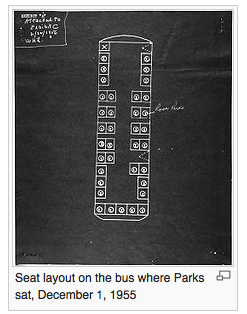 |
|
|
For years, the black community had complained that the situation was unfair. Parks said, “My resisting being mistreated on the bus did not begin with that particular arrest…I did a lot of walking in Montgomery.”
One day in 1943, Parks boarded the bus and paid the fare. She then moved to her seat but driver James F. Blake told her to follow city rules and enter the bus again from the back door. Parks exited the bus, but before she could re-board at the rear door, Blake drove off, leaving her to walk home in the rain.[12]
STOP Fueling the Bus!
A MegaChurch Transit Authority bus cannot run unless it has fuel. Just as a real bus runs on diesel gasoline and oil, there are two kinds of fuel that run the system’s buses:
- FUEL #1: FINANCES. Obviously, finances. Quit paying bus fares! It has been repeatedly suggested that if people left these churches behind, and quit funding these megachurch bus empires, the entire toxic culture would collapse.[13]
- FUEL #2: FEAR. Fear of man. This is a peer-driven culture. If only Christians could manage to extricate themselves, with the Lord’s help, from the toxic elements of a peer-driven culture, maybe — just maybe — they would suddenly experience FREEDOM! Freed from the need to be liked. Freed from the terrors of being ostracized by peers. Freed from the stigma of being “uncool.” Spiritual freedom from the toxic social-psychologies that manipulate the sheep. Freed from the postmodern lockstep mantras. Freed from the postmodern drivel — a lot of “conversations” full of hot air. Freed from the pressures to conform and perform. Freed from the need to “spin” everything rather than truly repent. Freed to be real and authentic and autonomous. Freed to believe in and minister the Gospel. Freed to fall prostrate at the cross and receive Christ’s redeeming Forgiveness. Freed to follow the real Jesus Christ of the Bible. Freed to step outside the purpose-driven box. Freed to be sheep quietly feeding on the Lord’s hills.
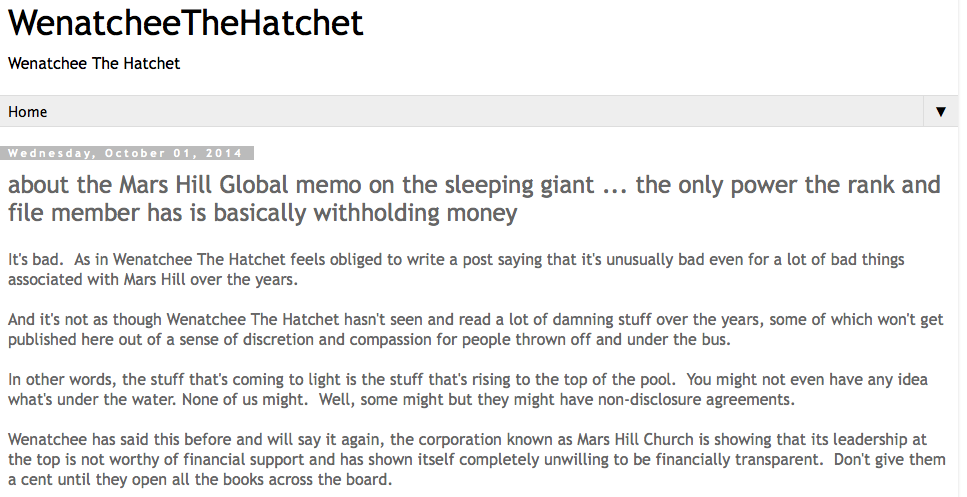
Stop paying bus fares!
Want to be truly radical? Become free from peer pressure? Want to become a real pace-setter? Follow Jesus and His way. To really live counter to the culture, one must separate from the collective crush and rush. The Bible talks about a narrow way. This dysfunctional MegaChurch Transit Authority goes down Broadway.
Want some advice? Get off the bus! On your own volition. Why stay on a dysfunctional toxic bus heading to a destination that only feathers the nest of an exalted leader?
“Think outside the bus”*
The MegaChurch Transit Authority’s bus system hopes that you will not think outside of its bus box. Don’t think! Just go along with the flow! It needs you to blindly believe its management mantras, advertising jingles, and success slogans. It has set itself up as an institutional structure in evangelicaldom. But it is already showing dangerous signs of decay, deconstruction and disease. New stories are cropping up every day. People are gaining courage and sharing their stories openly. They were tossed off the bus, but they survived. They are now standing at the bus depot picketing, warning others not to step foot onto this bus.
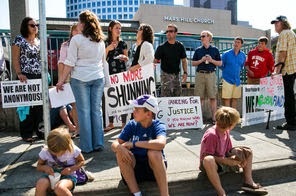 |
| “We Are Not Anonymous” demonstrators (Source) |
Many jumped on this bus in the first place because they had become disillusioned with normative evangelical Christianity and all of its flaws. And who can blame them? They went along for the ride, which promised new and exciting alternatives to the status quo. Many actually made it their life’s purpose to think, dream and communicate in a postmodern mindset. What an adventure! Others jumped onto the bus hoping to find answers, or peace, or community, or to have their “felt needs” met.
Regardless, there was indeed a starting point for the bus ride. And a point where they got tossed off the bus. That point of disembarkation might now seem like a wilderness. These folks may feel quite lost. And if they adopted a postmodern worldview, they may have no clue how to find their way. They may have already ruled out the Bible as a primary source of authority. In fact, it has been so badly discredited (did Paul really write this? Was Moses a real person? etc.) that it may seem utterly useless. The old authority has been deconstructed. Many even helped to do it. It is as if they know how to use a high-tech GPS but they never learned how to follow an old-fashioned paper roadmap. So now where do they go? What do they do?
It doesn’t help that many of the guru pastors who claim to represent traditional Bible-believing Christianity are now discovered to be part of the MegaChurch Transit Authority (i.e., Leadership Network) all along. Driscoll’s career course, from Emergent to Reformergent, to being accepted totally within the fold of New Calvinists, is a case in point. Nothing is as it seems.
Here is a tiny bit of help. Read our 4-part series on Herescope about “The Cult of Evangelical Leadership.”[14] We wrote at the time:
Sheep who read good old biblical material and start digesting meat will show signs of Strength and Vitality, and may suddenly pose a threat to the Shepherd! At this point there will be a crisis because the Sheep are listening and responding to another Shepherd – the Good Shepherd, Jesus Christ: “My sheep hear My voice, and I know them, and they follow Me:” (John 10:27) Note: A Scurrilous Shepherd will be threatened by a Sheep that follows Jesus Christ.
We believe there is hope in the Bible. It actually feels like a radical idea to turn to the Lord Jesus Christ. Some of us turned to Jesus Christ when we fled the postmodernism of the liberal Protestant denominations back in the early 1970s. There were bus disasters even then. We know firsthand that there is hope, and truth, love and life to be found in faith Jesus as our Savior.
By the way, the Bible even speaks to this “tossed off the bus” situation. For example, Pastor Larry DeBruyn, in the very next section of his book, penned the following words of encouragement:
As to
underhandedness, such maneuvering is that of false teachers. Jude
portrays false teachers as “certain men crept in unawares” (Jude 4;
Compare 2 Peter 2:1.). To the Ephesians Paul wrote of “the trickery of
men” and the “craftiness [of their] deceitful scheming” (Ephesians
4:14). Of his ministry to the Corinthians Paul wrote,
[W]e have
renounced secret and shameful ways; we do not use deception. . . . On
the contrary, by setting forth the truth plainly we commend ourselves to
every man’s conscience in the sight of God (2 Corinthians 4:2, NIV)
Pastoral
leadership must be conducted with openness and integrity. What the
people see is what they should get. Pastors should not harbor secret
agendas. Ministry should be pursued with integrity, godly character, and
candor. As with the false prophets in the Old Testament, God’s people
rightfully are alarmed at pastors and leaders who, figuratively
speaking, “wear a rough garment to deceive” (Zechariah 13:4). Godly
leadership should not be like that of “a wolf in sheep’s clothing,” that
deceives, upsets, slaughters, and scatters a local flock (Acts
20:28-30).
Endnotes:
1. The late Pastor Ken Silva, our dear friend and member of the Discernment Research Group, was always ahead of his time. See the following articles where he wrote about the controversial Driscoll bus comments back in 2012. This graphic comes from his article: http://apprising.org/2012/06/18/mark-driscoll-vision-casting-dead-bodies-his-mars-hill-bus-will-roll-over/ and also see: http://apprising.org/2012/07/03/mark-driscolls-dead-bodies-and-chris-rosebrough-with-another-ones-off-the-bus/ Note that the full transcript plus audio of Driscoll’s remarks is included.
2. Jim Collins, “Disciplined people: ‘Who’ before ‘what’,” http://www.jimcollins.com/article_topics/articles/good-to-great.html. Emphasis added. Also listen to “FIRST WHO, THEN WHAT”: http://www.jimcollins.com/media_topics/first-who.html
3. Jim Collins, Good to Great: Why Some Companies Make the Leap…And Others Don’t (HarperBusiness, 2001), p. 41.
4. Collins, “Disciplined people,” Ibid.
5. Ibid.
6. Ibid.
7. See partial summary of articles on this topic: https://dangeroushope.wordpress.com/2014/04/25/mars-hill-roundup-scandals-remain-not-much-changing/ Also see: http://www.patheos.com/blogs/warrenthrockmorton/2014/09/08/mars-hill-church-announces-more-layoffs-blames-people-for-lack-of-giving/
8. Bob DeWaay, Redefining Christianity: Understanding The Purpose Driven Movement, p. 52, emphasis added. This summary was found at: http://apprising.org/2010/02/26/dan-southerland-and-cult-like-hostile-takeover-tactics-of-purpose-drivenseeker-driven-church-transitioning/
9. http://www.svchapel.org/resources/book-reviews/5-church/667-transitioning-by-dan-southerland
10. All emphases added. The footnotes in this excerpt from Pastor Larry’s book are as follows:
[i] Sataline, “Popular Strategy.”
[ii] Ibid.
[iii] Ibid.
[iv] Pastors.com, Rick Warren’s MinistryToolBox, Issue #263, 6/14/2006, “What to do when your church hits a plateau.” Online at www.pastors.com/RWMT/default.asp?id=263&artid=4533&expand=1
[v] Sataline, “Popular Strategy.” In PDC, Warren states, “The church is a body not a business. . . . The task of church leadership is to discover and remove growth-restricting diseases and barriers so that natural, normal growth can occur.” See Rick Warren, The Purpose Driven Church, Growth Without Compromising Your Message & Mission (Grand Rapids: Zondervan Publishing House, 1995) 16. Assuming the Purpose-Driven philosophy is the paradigm by which church health is to be measured, the only judgment that can be made of those who do not get with the program is that they are like a cancer in the body that must be removed.
11. See: http://leadnet.org/bob-bufords-new-book-drucker-me/ “Meet Peter Drucker Through the Eyes of Bob Buford.” Here is a list of the men identified in this photo: Seated Front Row from the left: Randy Pope, Frank Tillapaugh, R. J. Ross, Bob Buford, Peter Drucker, David Hubbard, Larry DeWitt, Fred Smith, Jr.,Ted Engstrom, Paul Robbins. Standing Second Row from Left: John Huffman, Gordon MacDonald, Joe Aldrich, Bill Banowsky, John Vawter,Art DeKruyter, Bill O’Brien, Louis Knowles, Loren Mead, Norman Shawchuck, Carl George, Haddon Robinson, Leith Anderson. Back Row from Left: Robert Davis, Terry Fullam, John Pearson, Bobb Biehl, Bob Andringa, Bob Seiple, Paul Cedar, Gordon Loux, Bill Hybels, Harold Myra.
12. http://en.wikipedia.org/wiki/Rosa_Parks
13. Many people are calling this a toxic culture. See, for example, http://www.forbes.com/sites/robasghar/2014/09/16/how-toxic-followers-enable-toxic-leaders/ and http://oboedire.wordpress.com/2014/07/24/ministry-musings-toxic-leadership/
14. Sacred Cows and Stars, CA$H COW$ & FAT CAT$, Stuffed Shirts & Their Sycophants, and Scurrilous Shepherds & Their Starving Sheep
*”Think Outside the Bus” This subtitle phrase ise credited to a comic strip in the Cleveland Plain Dealer called “Crankshaft,” published on Thursday, October 2, 2014.

